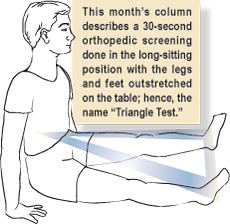I have always believed that one of the purposes of our profession should be to educate the public on how to maintain their health and prevent disease. In other words, chiropractic should specialize in health care as opposed to sick care, which is practiced by Western medicine. One of our main focuses should be differentiating somato-visceral causes of symptoms from viscero-somatic causes. Our chiropractic education certainly equips us to do so very well—in fact, better than anyone else in the healing arts. Yet few chiropractors seem to recognize this specialty is available to them.
Consider this: The vast majority of symptomatic patients do not have positive medical test results and a specific course of drug therapy cannot be established without identifying the true cause of such symptoms as:
Stiff, sore joints Constipation or diarrhea
Headaches Restlessness or irritability
Heartburn Anxiety
Indigestion Depression
Gas and bloating Insomnia
 Nevertheless, drugs are prescribed for these symptoms despite their known side effects. The underlying cause of these symptoms may be structural, but there may be a visceral cause exhausting the body’s ability to maintain normal structure and function. This is an important diagnostic question and every clinician should seek to answer it before initiating therapy.
Nevertheless, drugs are prescribed for these symptoms despite their known side effects. The underlying cause of these symptoms may be structural, but there may be a visceral cause exhausting the body’s ability to maintain normal structure and function. This is an important diagnostic question and every clinician should seek to answer it before initiating therapy.
I began this series of columns describing a screening procedure that should require less than five minutes and would quickly uncover the source of a patient’s symptoms. The subtitle of the series has been “What do you have to see before you know what to do?” It is a legitimate question. Have you confined yourself to performing a self-limiting technique procedure or do you search for the actual cause of the patients’ symptoms? Remember, once the cause is found, the treatment is obvious.
In previous articles, I suggested that you do a quick screening procedure by examining standing posture and a 30 second-screening procedure with the patient seated. I also suggested palpating for stress points (muscle contractions) that could be involved with each deviation from normal you observed. It is a basic scientific fact that any visceral dysfunction will produce contraction in those muscles that share the same neurological innervation as the involved organ. Obviously, these contractions then produce deviations from normal posture, regardless of the position the patient is examined in.
This month’s column describes a 30-second orthopedic screening done in the long-sitting position with the legs and feet outstretched on the table; hence, the name “Triangle Test.” In this position, it is quite easy to check Bechterew’s Straight Leg Test, Braggard’s Test for Sciatica, Lindner’s Sign, and spinal percussion. We will also examine for loss of the normal thoracic kyphosis in this position. These tests will help recognize orthopedic conditions including ruptured disk, fractured vertebrae, and neoplasms that would warrant additional diagnostic work-up.
Bechterew’s Straight Leg Test
Have the patients seated with their legs extended on the table. Ask them to straighten their knees (if possible) so they are flat on the table. If there is pain in the spine (not muscle tension in the legs), the test is positive for possible disk involvement. Obviously shortening of the hamstring muscles produces a dysfunction with the Rectus femoris known as Lombard’s paradox.
Braggard’s Test for Sciatica
After the patient has straightened their legs, passively dorsiflex the ankles by pushing up on the balls of the feet. This test is positive if it produces pain in the spine.
Lindner’s Sign—Meningeal Stretch
With the legs straight and the feet dorsiflexed, have the patient bend forward at the waist and drop their head toward their chest. The test is positive if pain occurs in the spine (not muscle tension) upon dropping the head and requires further examination for dural torque, among other possibilities.
Percussion
With the patient in Lindner’s position and using two fingers, tap (percuss) on the spinous processes starting in the neck and working your way to the bottom of the lumbar spine.
• If the patient experiences soreness with percussion, this indicates a strain or stress, such as arthritis or a subluxation.
• If the patient experiences sharp, stabbing, or knife-like pain, it may be indicative of a fractured vertebra.
• If the patient experiences pain that persists for several minutes after percussion, this is indicative of a possible neoplasm (tumor).
Any of the above findings require immediate diagnostic confirmation. The key to understanding this test is not if percussion causes pain, but how long the SHARP PAIN lasts.
Pottenger’s Saucer
Next, keep the patient bent forward at the waist with their head flexed. Slide your fingers down the spinous processes from T1 toward T12. You should feel the “C-shaped” posterior curve of a normal thoracic kyphosis.
Observe if there is a loss of the normal kyphosis and feel for a depression formed in the middle dorsal spine. This is referred to as a saucer because, if the patient were prone, it would hold water. This structural abnormality is associated with viscero-somatic stress that may involve the digestive organs, the spleen, adrenal glands, the heart and lungs. It is not a permanent or static condition. It is transitory and is found not only with digestive dysfunction, but also it is almost consistently found in muscle contractions producing headaches.
Next month, we will lay the patient supine and begin examining the abdomen for the source of Pottenger’s Saucer.
Dr. Loomis can be reached by mail at 6421 Enterprise Lane, Madison, WI 53719 or by phone at 1-800-662-2630. Visit his website at http://www.loomisenzymes.com.
